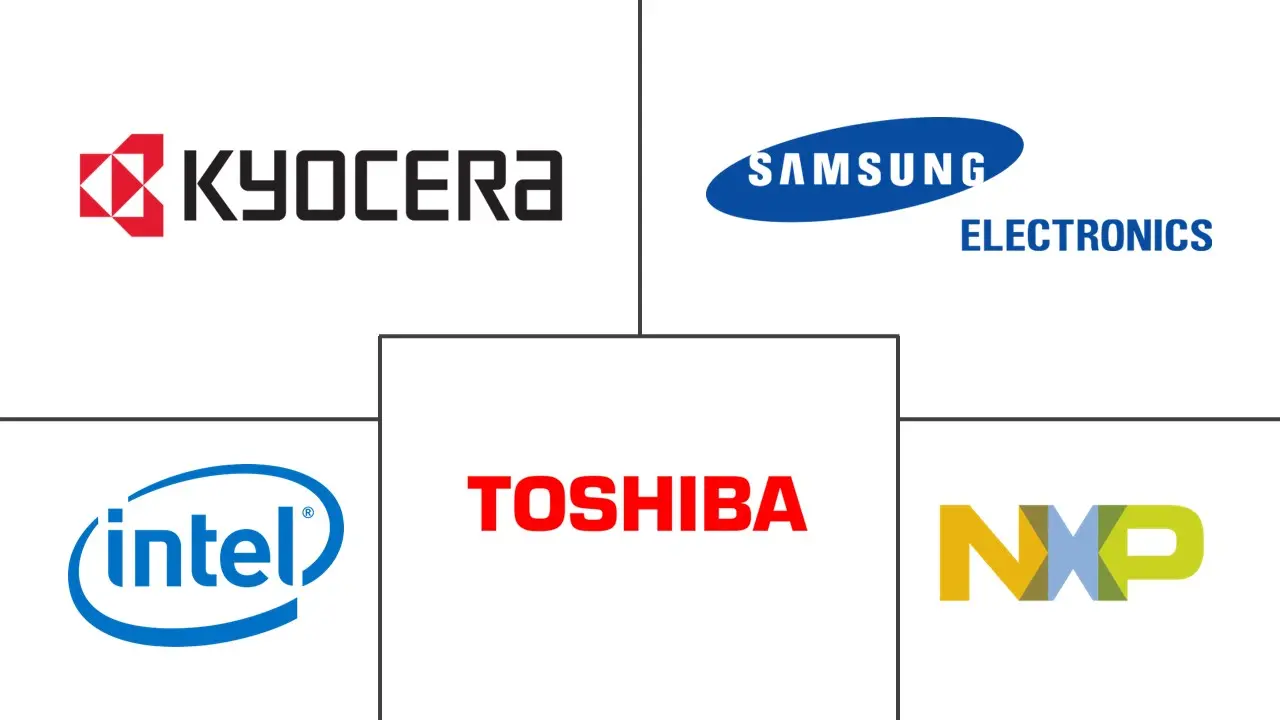Size and Share of Japan Semiconductor Device Market In Consumer Industry
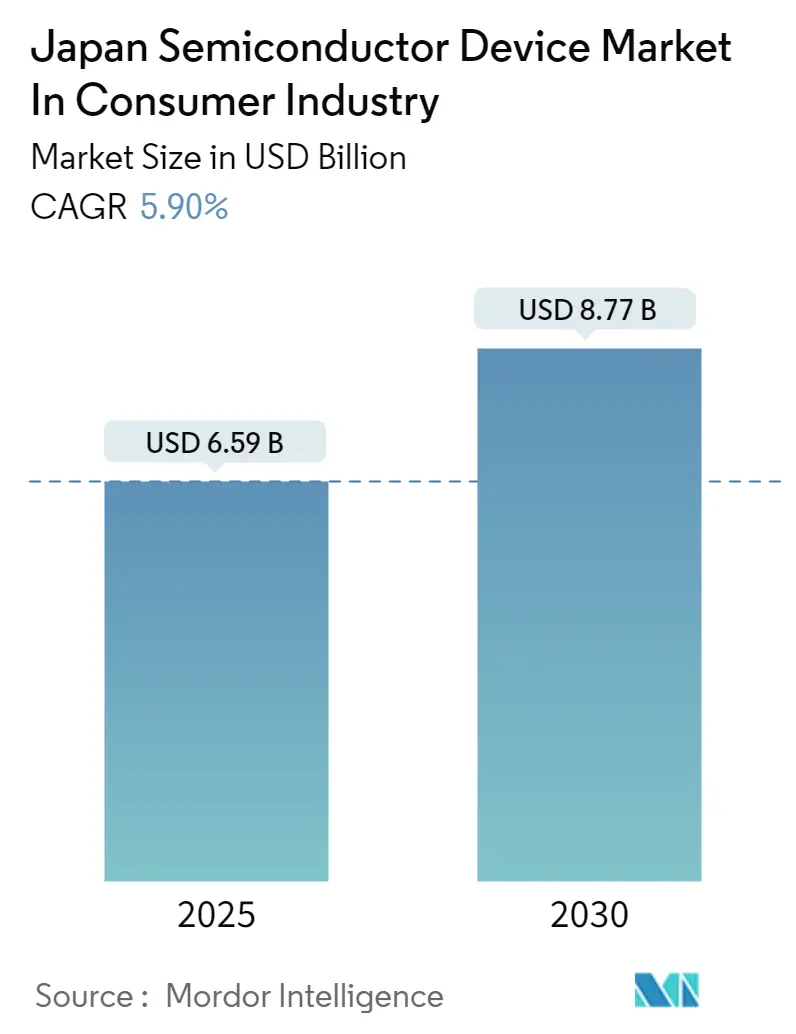
Analysis of Japan Semiconductor Device Market In Consumer Industry by Mordor Intelligence
The Japan Semiconductor Device Market In Consumer Industry is expected to grow from USD 6.59 billion in 2025 to USD 8.77 billion by 2030, at a CAGR of 5.9% during the forecast period (2025-2030).
The increasing production of consumer electronics across the country further drives the demand in the studied market. According to METI (Japan), in 2022, the production value of the Japanese electronics industry increased by 0.2% compared to the previous year. As a result, the production value amounted to almost JPY 11 trillion (USD 0.069 trillion).
A semiconductor device is an electronic element that depends on the electronic properties of a semiconductor material for its function. Further, in the consumer industry, CPUs operating personal computers are made with semiconductors. Also, many digital consumer products, such as smartphones, digital cameras, televisions, refrigerators, washing machines, and LED bulbs, also use semiconductors.
Vendors in the market have been continually focusing on developing new devices to address consumer requirements. In February 2022, TSMC, the world's significant contract chip maker, announced the USD 7 billion factory in southern Japan in November. Construction is scheduled to start this year, with production beginning by the end of 2024. That announcement was welcomed by the Japanese governance, which wants TSMC to construct plants to supply essential chips to Japan's electronic device makers and auto organizations as the trade conflict between the United States threatens to disrupt supply chains and demand for the component grows.
Further, the demand for wearables (fitness tracks, smartwatches, etc.) that offer health monitoring functionalities such as heart rate also shows an upward trend. Considering the growing demand, vendors are increasingly launching new wearable products with health-tracking features. For instance, Amazon recently launched its latest fitness tracker, "Halo View." The fitness tracker counts steps like other fitness trackers, accounts for crucial health metrics like blood oxygen levels and heart rate, and sends texts and reminder notifications.
Companies in Japan are investing in the semiconductor industry to build advanced businesses and sustainable growth. For instance, in November 2022, Micron started mass production of advanced DRAM memory chips in Japan. Micron's most advanced chip can store a third more data than older chips and comes as Japan attempts to revive and modernize its once-mighty chip industry.
In addition, in March 2023, Samsung Electronics Co. established a new semiconductor research center in Japan, combining two existing research and development institutes to advance its chip technologies and hire more talented R&D staff. The latest research center will play the role of Samsung's R&D control tower in Japan, focusing on designing and developing system LSI chips such as image sensors, application processors (APs), and modems. Such expansion in the country may further drive the studied market growth.
Moreover, COVID-19 negatively impacted the country's semiconductor device demand in the consumer industry. Semiconductors were used in most consumer gadgets that work on electricity or batteries. The need for semiconductors hampered critical care owing to their extensive use in smartphones, CPUs, televisions, refrigerators, and mobile ultrasound devices, among other things. Furthermore, the market is predicted to grow in the forecasted period as consumer industries across the country increase in the market.
Insights and Trends of Japan Semiconductor Device Market In Consumer Industry
Increasing Smartphone Penetration
The semiconductor devices in the consumer industry are estimated to continue their robust growth during the forecast period to accommodate the increasing demand for semiconductor materials in smart devices such as smartphones, laptops, Televisions, and many other consumer electronics, coupled with competition among key vendors and consistent spending on R&D.
The increasing proliferation of smartphones, feature phones, and tablets drives the market. Analog ICs are used in various applications, including third and fourth-generation (3G/4G) radio base stations and portable device batteries. RFICs (radio frequency ICs) are analog circuits that usually run in the frequency range of 3 kHz to 2.4 GHz (3,000 hertz to 2.4 billion hertz) circuits that would work at about 1 THz (1 trillion hertz). They are widely used in cell phones and wireless devices. The analog IC market in this segment is expected to grow as they are under development.
Moreover, the rising adoption of 5G smartphones further drives market growth. In April 2022, the Japanese government set a goal for a 5G ecosystem, according to which 99% of the population is anticipated to be serviced by 5G networks by the end of the fiscal year 2030. In addition, according to JEITA, the monthly domestic shipment volumes of mobile phones in Japan amounted to about 1.11 million units in December 2022.
Furthermore, the Japanese brand releases a few Xperia phones yearly. In April 2023, Sony announced the launch of a new Xperia phone in the Japanese market. The upcoming offering is anticipated to be the Sony Xperia 1V. The appliance will arrive as the successor to the last year's Xperia 1IV.
Additionally, in December 2022, Sony Group Corp invested about USD 5.83 billion to build a factory to make smartphone image sensors in western Japan. Such expansion in consumer electronics may further propel the studied market growth.
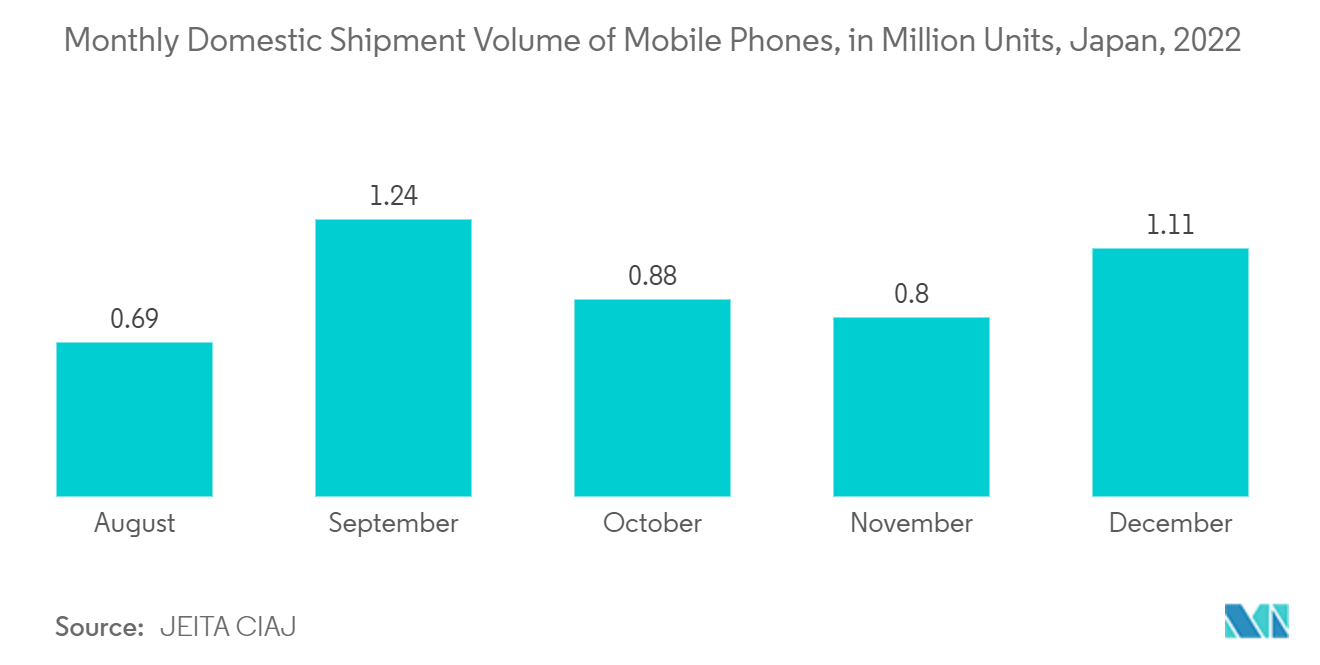
Microcontrollers (MCU) Holding the Significant Market Growth
The country is a hub for major consumer electronics companies such as Sony, Hitachi, Panasonic, Nikon, and Toshiba. According to Sony, the electronics products & solutions segment of Sony Corporation recently generated a sales result of approximately JPY 2.29 trillion (USD 0.014 trillion). In addition, in April 2022, the company reported a solid 16% increase in group sales compared to the previous year, totaling JPY 11.5 trillion (USD 0.072 trillion).
In addition, according to JEITA, the total production value of the electronics industry in Japan reached close to JPY11 trillion in 2022. The sector encompasses consumer electronic equipment, industrial electronic equipment, and electronic components and devices.
Furthermore, Microcontrollers are used in many home appliances, such as washing machines, air conditioners, vacuum cleaners, refrigerators, front panel keypad control, analog sensor measurements, and LED/LCDs. The industry uses 8-, 16-, and 32-bit microcontroller-based circuitry for motor control and TRIAC/LED/LCD drive applications. The increasing demand for IoT and AI in the country's consumer electronics and home appliances drives the need for microcontrollers.
Further, various companies are looking at constant inventions and upgrades to keep up with countries' microcontrollers' industrial evolution. For instance, Renesas Electronics, a Japanese semiconductor manufacturer, announced a massive investment in manufacturing capacity of more than 50% by 2023. The firm will focus on producing more high-end microcontrollers and other essential elements for electronics. Renesas aims for 40,000 200mm wafers a month by procuring more lines for outsourced production at chip foundries.
Further, Japan has recently announced the creation of a scheme to subsidize the construction of domestic chip factories, with a new plant planned by Taiwan-based TSMC to be the first recipient. The government will likely subsidize up to half of TSMS's estimated JPY one trillion investment for building a chip plant in Kumamoto, Southern Japan.
The rising mobile data traffic demands data speeds to exceed the rates used by analog technology. Thus, demands for improved circuit design are accompanied by calls for advanced components. This is expected to ultimately give rise to the use of advanced discrete semiconductors in the country. According to official data, internet users in Japan has a median mobile internet connection speed via cellular networks is 40.89 Mbps. The median fixed internet connection speed is 93.26 Mbps. in 2022.
Companies in the market are developing new products to provide their customers with various solutions. For instance, in June 2022, NXP Semiconductor announced a new MCX portfolio of microcontrollers designed to advance innovation in smart homes, smart factories, smart cities, and many emerging industrial and IoT edge applications. Such consumer electronics and semiconductor development developments may further propel the country's demand in the studied market.
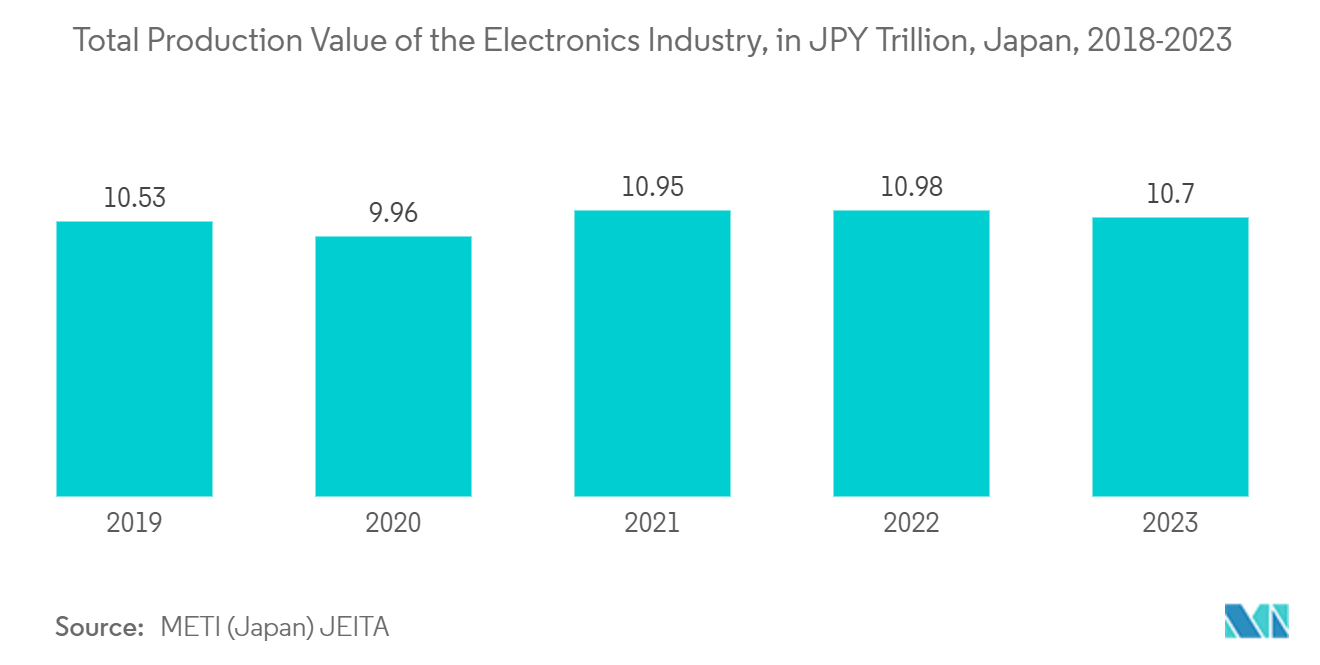
Competitive Landscape
Japan's Semiconductor Device Market in Consumer Industry fluctuates with growing mergers, technological advancements, and geopolitical scenarios. The Market is favorably competitive, with several players. The market space remains highly contested due to the economies of scale and nature of the product offerings, and the cost-volume metrics favor companies that operate with low-fixed costs. Some key players in the Market are Samsung Electronics Co. Ltd, Intel Corporation, and NXP Semiconductors NV, among others. Some key recent developments in the Market include:
June 2022- STMicroelectronics announced its partnership with Sensory Inc. to enable the STM32 microcontroller user community to develop and prototype voice-based user interfaces for wearables, IoT, and smart-home applications. The collaboration pair ST's STM32 hardware and software with Sensory'svoice-control technologies, including the new VoiceHubonline portal that helps the seamless creation of embedded speech-recognition models using voice-control command sets, custom wake words and large natural-language grammars in nearly twenty languages and dialects.
April 2022- Toshiba Electronic Devices and Storage Corporation has started the mass production of 21 new microcontrollers in the M3H group. The group includes an ARM Cortex-M3 core running up to 120MHz, integrated max 512KB code flash, and 32KB data flash memory with 100k write cycle endurance. The M3H Group microcontrollers are suited for various applications, including home appliances.
Leaders of Japan Semiconductor Device Market In Consumer Industry
-
Toshiba Corporation
-
Samsung Electronics Co. Ltd
-
Intel Corporation
-
Kyocera Corporation
-
NXP Semiconductors NV
- *Disclaimer: Major Players sorted in no particular order
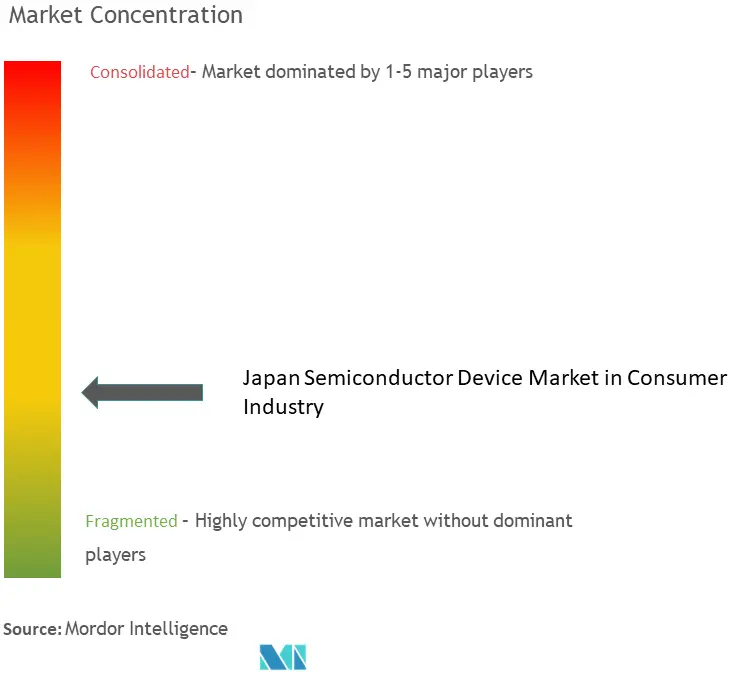
Recent Industry Developments
- April 2024: The Japanese government allocated JPY590 billion (USD 3.9 billion) to bolster Rapidus Corp's efforts in mass-producing 2nm logic chips. This funding supplements previous subsidies provided to Taiwan Semiconductor Manufacturing Co (TSMC) and Micron Technology.
- February 2024: Sony Semiconductor Solutions Corporation ("SSS"), DENSO Corporation ("DENSO"), and Toyota Motor Corporation ("Toyota") revealed plans for additional investments in Japan Advanced Semiconductor Manufacturing, Inc. ("JASM"), a subsidiary primarily owned by TSMC, located in Kumamoto Prefecture, Japan. This investment aims to establish a second fab, slated to commence operations by the end of 2027. Coupled with JASM's first fab, set to be operational in 2024, the collective investment in JASM is poised to surpass USD20 billion, bolstered by substantial backing from the Japanese government.
Scope of Report on Japan Semiconductor Device Market In Consumer Industry
A semiconductor's significance lies between the conductor and the insulator. It controls and handles the flow of electric current in electronic equipment and devices. As a result, it is a popular component of electronic chips made for computing components and different electronic devices, including solid-state storage.
The studied market is segmented by device types such as discrete semiconductors, optoelectronics, sensors, integrated circuits (analog, logic, memory, micro [microprocessors (MPU), microcontrollers (MCU), digital signal processors]). The impact of Covid-19 on the market and impacted applications are also covered under the scope of the study. Further, the disturbance of the elements affecting the Market's evolution in the near future has been covered in the study regarding drivers and restraints. The market sizes and forecasts are provided in terms of value (USD) for all the above segments.
| Discrete Semiconductors | ||
| Optoelectronics | ||
| Sensors | ||
| Integrated Circuits | Analog | |
| Logic | ||
| Memory | ||
| Micro | Microprocessors (MPU) | |
| Microcontrollers (MCU) | ||
| Digital Signal Processors | ||
| By Device Type | Discrete Semiconductors | ||
| Optoelectronics | |||
| Sensors | |||
| Integrated Circuits | Analog | ||
| Logic | |||
| Memory | |||
| Micro | Microprocessors (MPU) | ||
| Microcontrollers (MCU) | |||
| Digital Signal Processors | |||
Key Questions Answered in the Report
How big is the Japan Semiconductor Device Market in Consumer Industry?
The Japan Semiconductor Device Market in Consumer Industry size is expected to reach USD 6.59 billion in 2025 and grow at a CAGR of 5.90% to reach USD 8.77 billion by 2030.
What is the current Japan Semiconductor Device Market in Consumer Industry size?
In 2025, the Japan Semiconductor Device Market in Consumer Industry size is expected to reach USD 6.59 billion.
Who are the key players in Japan Semiconductor Device Market in Consumer Industry?
Toshiba Corporation, Samsung Electronics Co. Ltd, Intel Corporation, Kyocera Corporation and NXP Semiconductors NV are the major companies operating in the Japan Semiconductor Device Market in Consumer Industry.
What years does this Japan Semiconductor Device Market in Consumer Industry cover, and what was the market size in 2024?
In 2024, the Japan Semiconductor Device Market in Consumer Industry size was estimated at USD 6.20 billion. The report covers the Japan Semiconductor Device Market in Consumer Industry historical market size for years: 2019, 2020, 2021, 2022, 2023 and 2024. The report also forecasts the Japan Semiconductor Device Market in Consumer Industry size for years: 2025, 2026, 2027, 2028, 2029 and 2030.
Page last updated on:
Report on Japan Semiconductor Device Market In Consumer Industry
Statistics for the 2025 Japan Semiconductor Device In Consumer Industry market share, size and revenue growth rate, created by Mordor Intelligence™ Industry Reports. Japan Semiconductor Device In Consumer Industry analysis includes a market forecast outlook for 2025 to 2030 and historical overview. Get a sample of this industry analysis as a free report PDF download.
